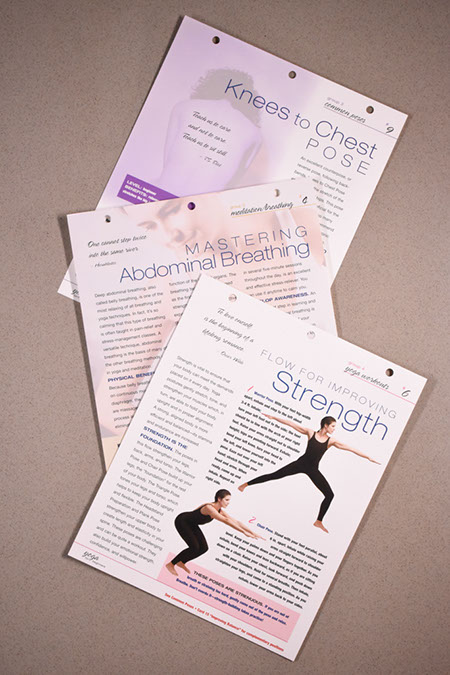
I’m a longtime practitioner of yoga, and was delighted to write a series of how-to yoga cards for International Masters Publishers. The cards were sold in packages, and collected in a top-loading binder for easy reference during study or practice.
Mastering Abdominal Breathing
“One cannot step twice into the same river.”
—Herakleitos
Deep abdominal breathing, also called belly breathing, is one of the most relaxing of all breathing and yoga techniques. In fact, it’s so calming that this type of breathing is often taught in pain-relief and stress-management classes. A versatile technique, abdominal breathing is the basis of many of the other breathing methods used in yoga and meditation.
Physical benefits. Because belly breathing focuses on continuous movement of the diaphragm, the abdominal organs are massaged and stimulated. This process aids efficient digestion and elimination, and also enhances the function of the internal organs. The breathing technique is also used as the first step in an abdominal-strengthening program; the active expansion and contraction of the diaphragm helps the muscles of your lower abdomen gain strength, flexibility, and tone.
Mental benefits. In this method, the extended inhalations and exhalations help focus your awareness inward. In addition to promoting feelings of tranquility, peace, and mental clarity, this focus helps you feel fully alive and present in the moment. Abdominal breathing, when practiced in one long session for 15–20 minutes or in several five-minute sessions throughout the day, is an excellent and effective stress reliever. You can use it anytime to calm you.
Develop awareness. An important first step in learning and mastering abdominal breathing is developing awareness of your usual breathing habits. Lie down on your back and bed your knees, so that your feet are flat on the floor. Close your eyes and turn your attention inward. Which parts of your body move as you breathe? Do you breathe through your mouth or your nose? How long are your inhalations and exhalations relative to each other? What else do you notice?
Let out a few long sighs (try making them loud and dramatic), and observe how that changes your breathing pattern. Make yourself yawn, too, which encourages deep breathing.
((box))
Abdominal breathing is particularly helpful in reversing the chest-only breathing that most of us do throughout the day. By forcing you to actively push out your belly as your inhale, this breathing pattern teaches you to bring the oxygen down past your chest cavity.
Preparation. Before you practice abdominal breathing, clear your nose and remove any noises or potential distractions from your surroundings. Give yourself several minutes to practice this breathing technique undisturbed.
Getting started. Begin by lying down on the floor, with your hips, back, and shoulders flat on the floor. Keep your knees bent toward the ceiling and the soles of your feet in contact with the floor, which releases your back muscles and helps you relax. Close your eyes and place your hands lightly on your belly. As you slowly and fully inhale, expand your abdomen, allowing the breath to round your belly and push it upward into your hands. Imagine that you are filling up a balloon located in your belly.
Exhale slowly, and gently press your belly downward with your hands. Allow your abdomen to empty completely; it should feel flat or even a bit concave.
Repeat the first two steps, concentrating on making the inhalation and the exhalation the same length of time. Count to four on both phases of the breath to facilitate your learning and make sure you are breathing slowly.
Repeat the first two steps again, but this time make the exhalation a few seconds longer than the inhalation. After exhaling, suspend your breath for just a few seconds—don’t breath in again just yet, and concentrate on the sensations in your abdomen and lungs. Repeat this step several times; allow yourself to fully relax and experience the flow of breath.
When you are finished with your practice, allow your breathing to return to normal, but remember what it feels like to breathe deeply and slowly from your abdomen. Open your eyes and roll onto your side. Always give yourself a couple of seconds to adjust before getting up, so that you don’t get dizzy.
Feelings of stress, anger, or fear can make us breathe shallowly from our chests without fully expanding our lungs. Become aware of the times during the day when this happens to you; then return to the practice of breathing deeply from your abdomen. Expel the tension with each exhalation.
Technique Tips
Try using some of these visualization techniques to help you learn proper abdominal breathing:
Erich Schiffman, who is a highly respected author and yoga instructor, recommends thinking of the body as an instrument through which wind—the breath—flows.
When inhaling, picture the breath radiating outward from your pelvis, then filling up your lower back and the sides of your abdomen.
As you exhale, imagine the tension leaking out of your body through your toes, fingertips, and the crown of your head.
Imaging a balloon floating up to the sky, taking with it any stress or worries as it slowly disappears from view.